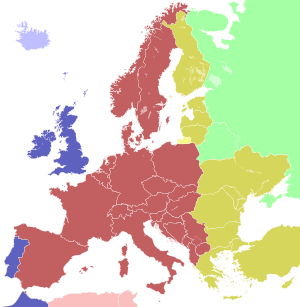Central European Summer Time

| light blue | Western European Time (UTC+0) |
| blue | Western European Time (UTC+0) Western European Summer Time (UTC+01:00) |
| pink | Central European Time (UTC+01:00) |
| red | Central European Time (UTC+01:00) Central European Summer Time (UTC+02:00) |
| yellow | Kaliningrad Time (UTC+02:00) |
| golden | Eastern European Time (UTC+02:00) Eastern European Summer Time (UTC+03:00) |
| light green | Minsk Time, Moscow Time (UTC+03:00) |
Central European Summer Time (CEST) is the standard clock time observed during the period of summer daylight-saving in those European countries which observe Central European Time (UTC + one hour) during the rest of the year. It corresponds to UTC + two hours.
Names
Other names which have been applied to Central European Summer Time are Middle European Summer Time (MEST), Central European Daylight Saving Time (CEDT), and Bravo Time (after the second letter of the NATO phonetic alphabet).
Period of observation
Since 1996 European Summer Time has been observed between 1:00 UTC on the last Sunday of March and 1:00 on the last Sunday of October; previously the rules were not uniform across the European Union.[1]
Usage
The following countries and territories use Central European Summer Time.
- Albania, regularly since 1974
- Andorra, regularly since 1985
- Austria, regularly since 1980
- Belgium, regularly since 1980
- Bosnia and Herzegovina, regularly since 1983
- Croatia, regularly since 1983
- Czech Republic, regularly since 1979
- Denmark (metropolitan), regularly since 1980
- France (metropolitan), regularly since 1976
- Germany, regularly since 1980
- Gibraltar, regularly since 1982
- Hungary, regularly since 1983
- Italy, regularly since 1968
- Liechtenstein
- Luxembourg, regularly since 1981
- Malta, regularly since 1974
- Monaco, regularly since 1976
- Montenegro, regularly since 1983
- Netherlands, regularly since 1977
- Norway, regularly since 1980
- Poland, regularly since 1977
- Republic of Macedonia, regularly since 1983
- San Marino, regularly since 1966
- Serbia, regularly since 1983
- Slovakia regularly since 1979
- Slovenia, regularly since 1983
- Spain (except Canary Islands, which apply Western European Summer Time instead), regularly since 1974
- Sweden, regularly since 1980
- Switzerland, regularly since 1981
- Vatican, regularly since 1966
CEST was used also in the years 1993–1995 in Portugal and 1998–1999 in Lithuania.
See also
- European Summer Time
- Other countries and territories in UTC+2 time zone
- Other names of UTC+2 time zone
References
- ↑ Joseph Myers (2009-07-17). "History of legal time in Britain". Retrieved 2009-10-11.